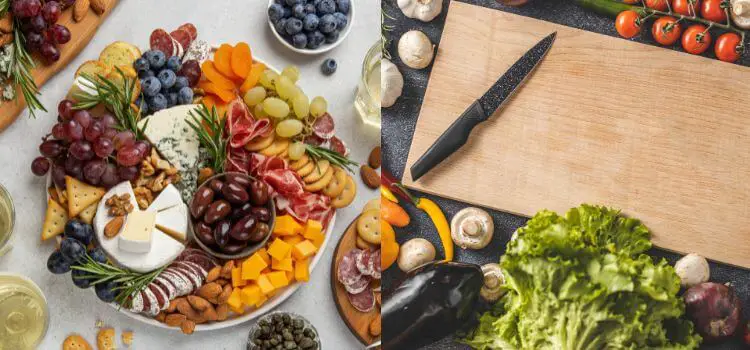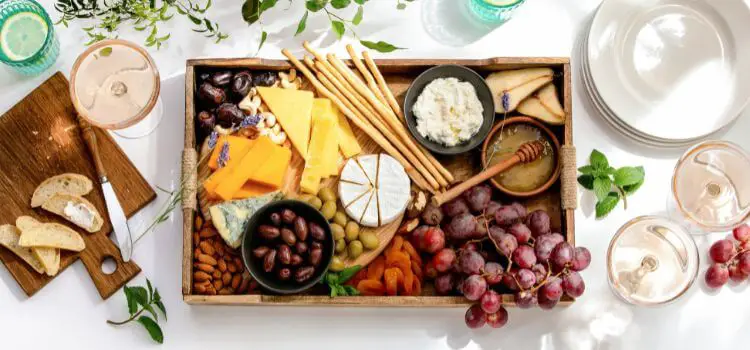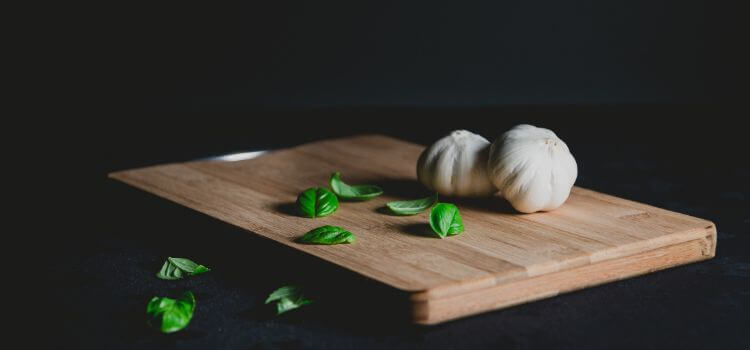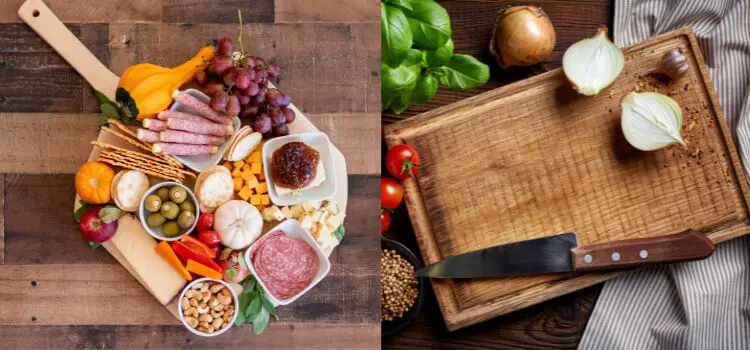As an Amazon Associate, I earn from qualifying purchases

In the world of culinary delights, the battle between the charcuterie board and the cutting board is a clash of flavors, textures, and presentation. These two kitchen staples have distinct roles in food preparation and presentation, each bringing its unique flair.
Join us in delving into the subtleties, similarities, and artistry of these essential tools, as we uncover how to create delicious spreads and dishes.
The Charcuterie Board

A charcuterie board is a serving platter typically used for arranging and displaying various cured meats, cheeses, fruits, nuts, and other flavorful accompaniments. “charcuterie” refers to prepared meat products such as sausages, pâtés, terrines, and cured meats like prosciutto or salami in French cuisine.
The objective of a charcuterie board is to craft a visually stunning and tasteful arrangement, savored either as a starter or a casual dining experience. Various textures, flavors, and colors can be showcased in one convenient and enticing presentation.
Key elements of a charcuterie board
- Meats: As the show’s star, cured meats are a must-have on any charcuterie board. These can include prosciutto, salami, chorizo, coppa, or any other cured meats you choose.
- Cheeses: Various kinds of cheese are crucial for creating a balanced and diverse flavor profile. Soft cheeses, such as brie and goat cheese, along with hard varieties like aged cheddar and gouda, and blue cheeses are all great options to include.
- Accompaniments: To complement the meats and cheeses, a selection of fruits, nuts, olives, pickles, spreads, and crackers can be added. These add texture and flavor to the board and provide various options for pairing with meats and cheeses.
Tips for creating an impressive charcuterie board
- Balance: Aim for a balance of flavors, textures, and colors on your charcuterie board. Mix up soft and hard cheeses, salty and sweet accompaniments, and different types of meats to create a harmonious spread.
- Arrangement: When arranging the items on your board, start with larger items like cheese wedges or bowls of spreads, then fill the spaces with smaller items like nuts or fruits. This approach will result in a visually attractive and well-organized presentation.
- Variety: Don’t be afraid to experiment with different flavors and ingredients on your charcuterie board. This is a great opportunity to try new combinations and showcase your creativity.
The Cutting Board

A cutting board is a flat, sturdy surface for chopping, slicing, and dicing food items. Commonly crafted from wood, plastic, or bamboo, it is available in a diverse array of sizes and shapes.
The primary purpose of a cutting board is to provide a safe and sanitary surface for food preparation. It also helps protect countertops from scratches and knife marks.
Types of cutting boards
- Wooden cutting boards: These are traditional and popular choices for their durability, knife-friendliness, and ability to prevent bacteria growth.
- Plastic cutting boards: These cutting boards offer an economical, lightweight solution that simplifies cleanup. They come in various colours, making it easier to designate specific ones for certain types of food.
- Bamboo cutting boards: Like wooden cutting boards, bamboo is a sustainable and eco-friendly option. It is also known for its natural antimicrobial properties.
Tips for using a cutting board
- Sanitation: To avoid cross-contamination, utilizing distinct cutting boards for raw meat, vegetables, and other food products is crucial.
- Maintenance: Wooden and bamboo cutting boards must be oiled regularly to prevent drying and cracking. Plastic cutting boards can either be cleaned in the dishwasher or disinfected using bleach for optimal hygiene.
- Size and shape: Choose a cutting board that works best for your kitchen needs. Consider the amount of counter space you have and the types of food you will be preparing.
Differences Between Charcuterie Board and Cutting Board

Contrasting purposes and roles:
- Primary purpose: Charcuterie boards are primarily used for serving and presenting food while cutting boards are used for food preparation.
- Materials: Charcuterie boards typically feature wood or marble construction, whereas cutting boards come in a diverse array of materials, including wood, plastic, and bamboo.
- Design elements: Charcuterie boards are typically more intricate and decorative while cutting boards are simpler.
- Maintenance: Charcuterie boards require regular cleaning and oiling to maintain their appearance, while plastic cutting boards can easily be washed in the dishwasher.
Enhances the overall dining experience:
- Visual appeal: Charcuterie boards are visually appealing and can be used as a centerpiece for gatherings while cutting boards are more functional than decorative.
- Variety of flavors: Charcuterie boards offer a variety of flavors and textures in one spread, making it an ideal option for grazing or appetizers. Cutting boards allow for precise food preparation, resulting in well-balanced and flavorful dishes.
- Craftsmanship: Charcuterie boards require careful selection and arrangement of ingredients to create a visually appealing spread while cutting boards require skillful knife techniques for precise cuts and dicing.
Practical considerations when choosing one:
- Gathering size: Charcuterie boards are a great option for larger gatherings as they can accommodate a variety of food items. In contrast, cutting boards may be more suitable for intimate gatherings or small meals.
- Food selection: If you’re hosting a dinner party with a specific theme or cuisine, a charcuterie board may be the better choice to showcase different flavors and ingredients. A cutting board may be more practical if you’re preparing a specific dish.
- Budget: Charcuterie boards can range from simple and affordable to elaborate and expensive while cutting boards are generally more budget-friendly. When choosing the right option for your occasion, it’s crucial to take your budget into account.
Conclusion
Both charcuterie boards and cutting boards play important roles in the kitchen. While they serve different purposes, they both contribute to creating an enjoyable dining experience. Whether you’re throwing a party or crafting a meal, opt for the choice that aligns perfectly with your requirements and budget.
With careful selection and arrangement of ingredients on a charcuterie board or precise food preparation on a cutting board, you can create delicious and impressive spreads for any occasion. Happy hosting!
As an Amazon Associate, I earn from qualifying purchases